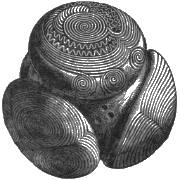NMS Archaeology Object 387600: X.1995.93.7 - Necklace
Description
Summary
Two-string necklace of cannel coal and lead beads, from the short cist cemetery at West Water Reservoir, West Linton, Peeblesshire, Early Bronze Age
Accession Number
X.1995.93.7
Other references
| Classification number Obsolete MOS number | X.EQ 1033 X.1997.1022 |
|---|
Original description
[MOS List, II.5.1, Death: object list by case, JAS 3.2.98. Case no.: V09 - Identity: age/babies and children]. [One of] Examples of high status child burials: - cannel coal and lead necklace from child inhumation, West Water Reservoir. PK note: Provisional 1997 register number allocated to MOS object. Finds from excavations at West Water Reservoir, West Linton, Peeblesshire. Type of site: Short cist cemetery. Date: Early Bronze Age. Finds from the Early Bronze Age cemetery (area A). [EQ 1033]. Cannel coal and lead necklace, cist 3 (= sf 18, 19, 65). Two-string necklace, the outer with a graduated string of 181 cannel coal disc beads, the inner with 31 lead beads separated by lost organic beads, or perhaps held in place by knots. The beads on the north side of the necklace were disturbed, suggesting the body had lain on its right hand side facing south, with these beads settling and separating somewhat as the corpse decomposed. The outer string comprised 181 cannel coal disc beads, graded in size from smaller ones (4 mm diameter) at the terminals to larger ones (10 mm diameter) in the centre. The exact position of a few beads was uncertain owing to disturbance during decay of the body, but most were recovered in the sequence as strung. The plot of bead dimensions shows this gradation, and indicates both the consistency of the perforations and the lack of correlation between thickness and diameter. Indeed, many of the beads were somewhat wedge-shaped in profile. These features indicate that the necklace was made from tapering cylinders of cannel coal which were perforated before individual beads were split off, a method noted for other such necklaces. Wear on the perforation holes, and the partial breakage of one bead, indicates that the necklace was not made specifically for burial but saw use before deposition. No fastener was found; the overlapping lines of beads behind the neck may indicate the two ends of the string were simply tied in a knot. The identification as cannel coal is based on the NMS standard methodology of X-ray fluorescence, X-radiography and detailed visual inspection supported by inspection of a small fragment by scanning electron microscope. The material is likely to be local. The inner string comprises 31 small lead beads whose spacing suggests the former presence of organic beads between them, although it is possible that they could have been held apart by knotting the string. The spacing varied, with gaps being wider at the sides, reduced to as little as 2 mm at the front.The beads were heavily corroded: only in one instance was any metallic lead noted ...Four beads (nos 2, 22, 26 & 29) were sampled by Brenda Rohl for lead isotope analysis as part of a larger study of Bronze Age material. They showed that the lead is consistent with a Southern Uplands or Central Scottish Midland Valley source, although they could match a number of English ore fields, including the Lake District and Southern Pennines. Such lack of precise provenancing is typical for British ore sources. Interestingly the beads do not match the isotope ratios for the most local source, at Siller Holes within 3 km of the site. Qualitative X-ray fluorescence revealed no detectable silver in the beads. [As well as the strung necklace, there is a box with a few lead flakes in storage.]
Associated person/people (e.g. excavator/former collection)
None
Discovery / field collection
Date of discovery
Not recorded
Method (e.g. excavation)
Excavated
Place (i.e. location of discovery)
West Water Reservoir, West Linton, Peeblesshire, Scotland, Northern Europe
Grid reference
Not recorded
Acquisition
Acquisition date
1995
Acquisition source (i.e. name of donor)
Queen's and Lord Treasurer's Remembrancer
Acquisition source role (e.g. donor)
Agent
Image
Identifiers and Links to Other Records
Would you like to help find more links?
| Identifier / External Link | Linked Record | Status | Comment |
|---|---|---|---|
| Canmore Site Id: 72107 | WEST WATER RESERVOIR - LINTON (TWEEDDALE) - CIST(S) (PERIOD UNASSIGNED), AWL (COPPER), BEAD(S), BEAKER(S), DISC(S) (CANNEL COAL), FOOD VESSEL(S) | Definite | West Water Reservoir cists/grave goods |
| NMS Accession Number: X.1995.93.7 | No linked record | Identifier supplied by NMS |
This area is visible only to logged in users.
